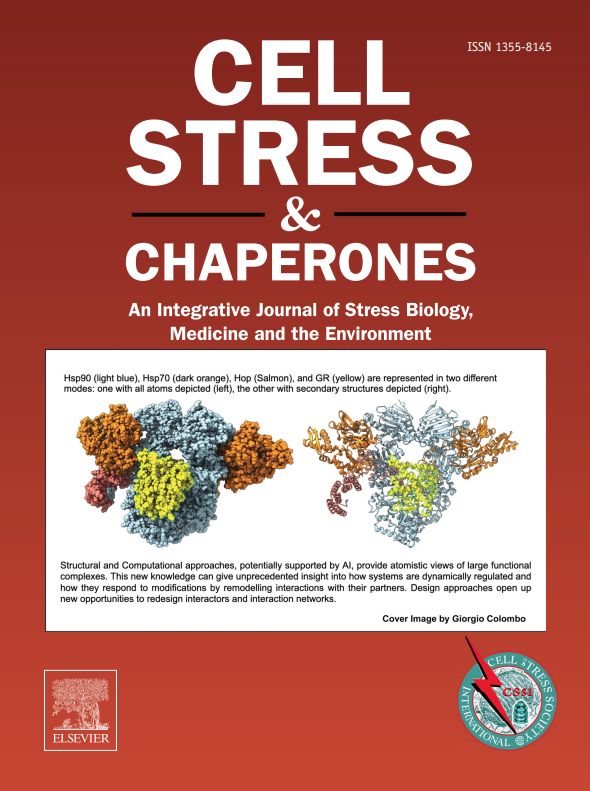哺乳动物热休克因子1在中枢神经系统中的多重作用
IF 3.2
3区 生物学
Q3 CELL BIOLOGY
引用次数: 0
摘要
热休克因子1 (HSF1)是一种与热应激反应和蛋白质折叠相关基因的转录调控密切相关的应激保护转录因子。在HSF1的典型激活周期中,HSF1识别一个简单的启动子结合位点,称为热休克元件(HSE),以促进分子伴侣的转录,这已经得到了很好的记录。然而,现在很明显,哺乳动物HSF1表现出意想不到的复杂性,并参与对大量细胞应激类型的反应。HSF1的多功能性可归因于不同的局部蛋白浓度、翻译后修饰(PTMs)和在哺乳动物系统不同解剖区域发现的结合伙伴。我们对HSF1在不同类型压力下的知识的进展已经阐明了它的大量基因靶点,从蛋白质折叠到线粒体稳态到细胞骨架稳定性等等。在这篇综述中,我们探讨了目前对哺乳动物HSF1及其在中枢神经系统中的基因靶点的了解。虽然HSF1已经在神经退行性变的背景下被广泛研究,但我们对其在这种情况下的不同作用的理解仍然有限。我们还强调了支持HSF1在健康大脑中的生理作用的新证据,这一领域受到的关注相对较少。推进对HSF1在哺乳动物大脑中的功能的更全面的了解可能有助于开发旨在减轻一系列神经系统疾病症状的新疗法。本文章由计算机程序翻译,如有差异,请以英文原文为准。
Multifaceted roles of mammalian heat shock factor 1 in the central nervous system
Heat shock factor 1 (HSF1) is a stress-protective transcription factor most associated with transcriptional regulation of genes involved thermal stress response and protein folding. The canonical activation cycle of HSF1, in which HSF1 recognizes a simple promoter binding site known as a heat shock element (HSE) to promote the transcription of molecular chaperones, has been well documented. However, it is now evident that mammalian HSF1 exhibits unexpected complexity and participates in the response to a vast array of cellular stress types. The versatility of HSF1 can be attributed to distinct local protein concentrations, posttranslational modifications (PTMs), and binding partners found in different anatomical regions of the mammalian system. Advances in our knowledge of HSF1 under different types of stress have illuminated its vast array of gene targets, ranging from protein folding to mitochondrial homeostasis to cytoskeletal stability and beyond. In this review, we explore current knowledge of mammalian HSF1 and its gene targets within the central nervous system. While HSF1 has been extensively studied in the context of neurodegeneration, our understanding of its diverse roles in this setting remains limited. We also highlight emerging evidence supporting a physiological role for HSF1 in the healthy brain, an area that has received relatively little attention. Advancing a more comprehensive understanding of HSF1 function in the mammalian brain may aid in the development of novel therapeutics aimed at alleviating symptoms across a range of neurological disorders.
求助全文
通过发布文献求助,成功后即可免费获取论文全文。
去求助
来源期刊

Cell Stress & Chaperones
生物-细胞生物学
CiteScore
7.60
自引率
2.60%
发文量
59
审稿时长
6-12 weeks
期刊介绍:
Cell Stress and Chaperones is an integrative journal that bridges the gap between laboratory model systems and natural populations. The journal captures the eclectic spirit of the cellular stress response field in a single, concentrated source of current information. Major emphasis is placed on the effects of climate change on individual species in the natural environment and their capacity to adapt. This emphasis expands our focus on stress biology and medicine by linking climate change effects to research on cellular stress responses of animals, micro-organisms and plants.
 求助内容:
求助内容: 应助结果提醒方式:
应助结果提醒方式:


